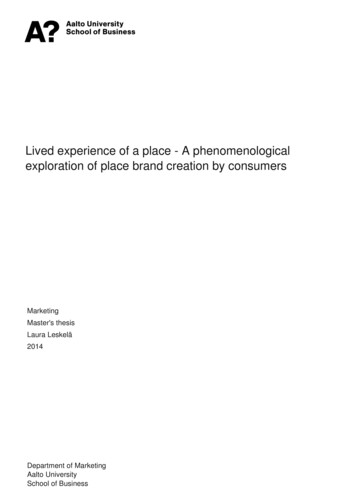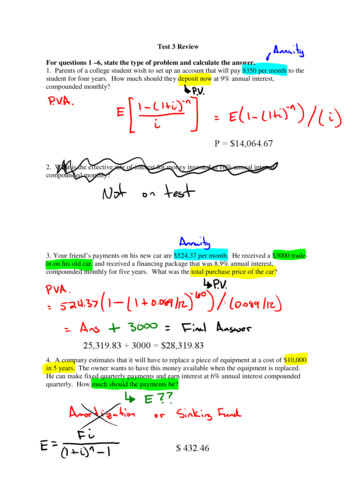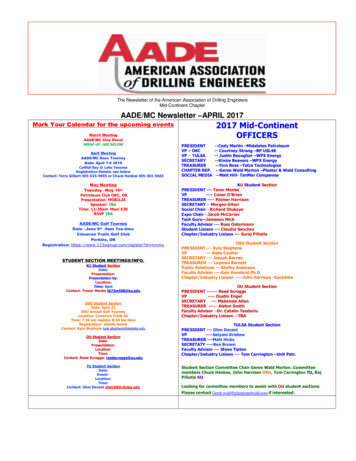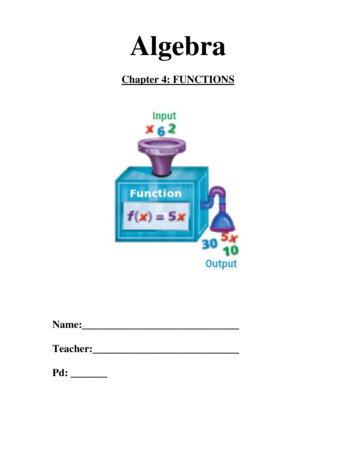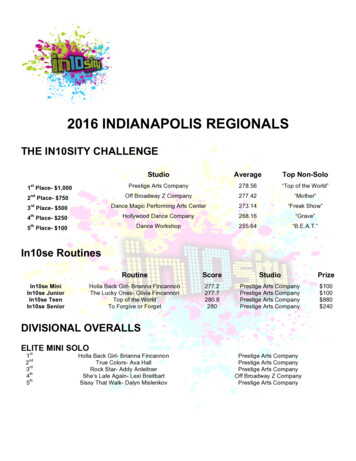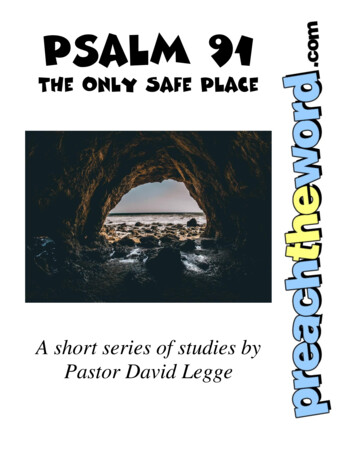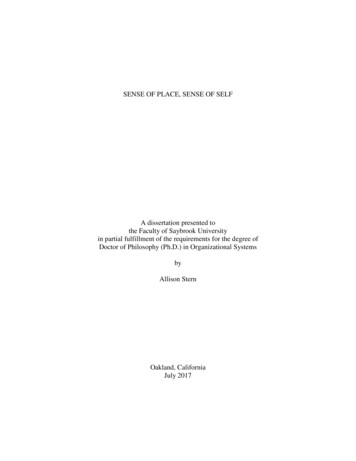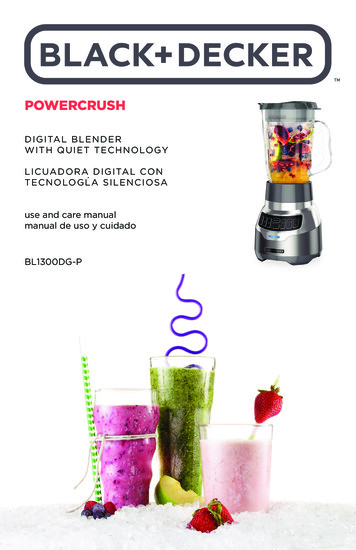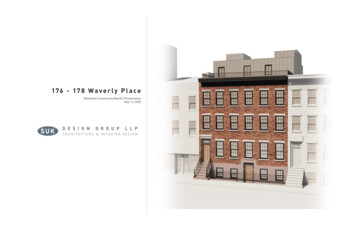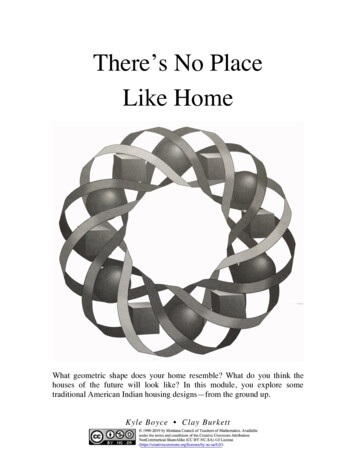
Transcription
There’s No PlaceLike HomeWhat geometric shape does your home resemble? What do you think thehouses of the future will look like? In this module, you explore sometraditional American Indian housing designs—from the ground up.Kyle Boyce Clay Burkett
There’s No Place Like HomeIntroductionTraditional American Indian dwellings vary from tribe to tribe and from region toregion. Those who lived in what is now South Dakota used tipis, the tribes of theAmerican Southwest chose pueblos, while the peoples of the Far North built igloos(also called illuliaqs). Differences in climate, terrain, building materials, andcultures were all important factors in the development of appropriate housingdesigns.The design of a house affects such practical considerations as the amount ofbuilding material needed, the amount of space enclosed, and the relative heatingor cooling efficiency of the dwelling. As the end 21st century begins, bothbuilding materials and heating fuels are growing scarce. Houses of the future mustmake efficient use of our resources.Examining some traditional American Indian housing designs may helpsuggest some possible designs for efficient homes in the next century. In thismodule, you examine several types of structures, the geometric shapes thatrepresent them, and the properties that help make buildings efficient.Activity 1The amount of floor space in a home is important to the comfort of its owners.Many colonial houses had rectangular floors. In this case, the area of the floor isrelatively easy to determine. The floor of a large tipi, however, could be a regularpolygon with as many as 18 sides.ExplorationHow could you find the area of a floor shaped like an 18-sided regular polygon?The area of a geometric figure refers to the region enclosed by it. The area of apolygon may be found by estimating, by using a formula, or by other means.In this exploration, you calculate area by inscribing a regular polygon inside acircle. An inscribed polygon is one in which each vertex lies on a circle. Theradius of an inscribed regular polygon is equal to the radius of the circle.149
For example, Figure 1 shows a square inscribed in a circle, with the radius ofthe square drawn from the square’s center to one of the vertices.2 cmFigure 1: Inscribed square with a radius of 2 cma.1. Construct a circle on a geometry utility. Record its radius, area,and perimeter.2. Select three points on the circle to represent the vertices of aninscribed triangle.3. Connect the center of the circle to each of the three points to formthree central angles. A central angle is an angle with its vertex atthe center of a circle.4. Move the points along the circle, one at a time, until the centralangles all have equal measures.5. Connect the three points on the circle to form a regular triangle.b.1. Use the geometry utility to calculate the triangle's area andperimeter.2. Record this information in a table.c.Using a process similar to that described in Part a, inscribe a regularquadrilateral, pentagon, hexagon, octagon, and 18-sided polygon incircles of the same radius.d.In your table from Part b, record the area and perimeter of eachregular polygon, as well as the area and perimeter of the circle inwhich they were inscribed. Note: Save your data for use in thediscussion.Discussiona.How did you determine the locations of the vertices for your inscribedpolygons?b.In Parts a and c of the exploration, why does creating congruentcentral angles guarantee that a regular polygon will be formed?c.1. What methods do you know for determining the area of regularpolygons?2. What are the advantages and disadvantages of each one?150
d.Consider a set of regular polygons inscribed in the same circle. As thenumber of sides in a polygon increases, describe what happens to eachof the following characteristics:1. the shape of the polygon2. the area of the polygon3. the perimeter of the polygon.e.A tangent to a circle is a line, segment, or ray that intersects a circle inone point and is perpendicular to a radius at that point. Consider apentagon whose sides are each tangent to a circle, as shown in Figure 2below. In this case, the polygon circumscribes the circle.Figure 2: A circle circumscribed by a regular pentagonConsider a set of regular polygons that circumscribe the same circle.As the number of sides in a polygon increases, describe what happensto each of the following characteristics:1. the shape of the polygon2. the area of the polygon3. the perimeter of the polygon.151
f.Figure 3 below shows a regular pentagon inscribed in a circle. In thiscase, AG is an apothem, a segment whose measure is the perpendiculardistance from the center of a regular polygon to one of its sides.CBDAapothemFGEFigure 3: A regular pentagonOne formula for the area of a regular polygon is1A ap2where a is the length of the apothem and p is the perimeter of thepolygon. (See the Level 1 module, “A New Look at Boxing.”)1. As the number of sides of an inscribed regular polygon increases,what do the values of a and p approach in relation to the circle?2. How does this affect the formula for the area of a regular polygongiven above?152
Assignment1.1The diagram below shows a view of a tipi from above. The floor ofthe tipi is an 18-sided regular polygon with a radius of 5 m.BAD CUse this diagram to determine each of the following:a. the measures of ABC and ABDb. the length of AD (using trigonometry)c. the length of ACd. the length of BDe. the area of ΔABCf. the area of the tipi’s floor.1.2The Powder House in Williamsburg, Pennsylvania, was built in 1714and used for storing gunpowder. As shown in the diagram below, thestructure has a regular octagonal base. Given that the longestdiagonals measure 16 m, determine the area of the floor.153
1.31.4Igloos are built from blocks of snow. The floor of an igloo is a circle.If an igloo has a diameter of 3.5 m, what is the area of its floor?*****The diagram below shows the regular hexagonal floor of a moderndomed camping tent. Given that each side is 1 m long, determine thearea of the floor.1m**********Research ProjectChoose one American Indian tribe—or several tribes from a single region—andstudy their traditional buildings. Describe each structure’s practical, seasonal, andcultural uses. Then describe each structure from a mathematical point of view,including its shape, geometric properties, and typical dimensions.Activity 2When an architect designs a house, the desired amount of floor space is only oneconsideration. Available building materials also play a role in determining anappropriate design. In some situations, appearance is a primary consideration; inothers, durability and cost are the main concerns. In any case, estimating theamount of materials required is an important part of the planning process. Whendetermining the amount of material needed to build a house, it is helpful tocalculate the area of the walls, floor, and roof.154
American Indian families in the Yukon region of Alaska and Canada oftenbuilt double lean-tos such as the one shown in Figure 4.4.7 m3.2 mFigure 4: A double lean-toA double lean-to can be described as a right triangular prism with bases that areequilateral triangles. The total surface area of a prism is the sum of the lateralsurface area and the areas of the two bases. For example, Figure 5 shows a net fora right triangular prism. In this case, the three rectangles in the net are the lateralfaces of the prism. The sum of their areas is the prism’s lateral surface area.BC.2ADFigure 5: Net for a right triangular prismDiscussiona.1. Why is it incorrect to consider a rectangle as a base of the prism inFigure 5?2. Why is this prism called a “right” prism?155
b.How are the dimensions of rectangle ABCD in Figure 5 related to theperimeter of the prism’s base?c.Describe how to find the surface area of a right prism with a squarebase.d.Figure 6 shows a net for a right circular cylinder.rrFigure 6: Net for a right circular cylinder1. What does the length of the rectangle’s longer side represent?2. What part of the net represents the height of the cylinder?3. What do the circles represent?4. Express the length of the rectangle’s longer side in terms of theradius of the circle.5. Describe how to find the total surface area of a cylinder.Assignment2.1The Powder House described in Problem 1.2 can be modeled by aright regular octagonal prism. A similar building, shown in thediagram below, is 11 m high. Each side of a base is 6 m long.a. Sketch a net for the building.b. Label the dimensions of one of the net’s lateral faces.c. Determine the building’s lateral surface area.d. Calculate the area of the bases.e. Determine the total surface area of the building.156
2.2a. Sketch a net for a prism whose bases are regular heptagons.b. As the number of sides in the bases of a prism increase, whatgeometric shape does the prism approach?2.3To help estimate the amount of material needed to build the doublelean-to shown in Figure 4, determine its total surface area.2.4The Pueblo Indians of the Rio Grande region lived in rectangularflat-roofed homes. As shown in the diagram below, these dwellingsresemble an early version of the modern apartment building.The right rectangular prism below shows some possibledimensions for a single-family unit in a Pueblo village. Use thesemeasurements to determine the total surface area of one family’shome.2.2 m2.53.4 m3.8 mA traditional wigwam of the Chippewa tribe and a modern Quonsethut share the same basic shape: a half cylinder. The Chippewas usedwigwams as sweat lodges. Quonset huts with translucent walls arecommonly used as greenhouses. Complete Parts a–d for the Quonsethut shown below.a.b.c.d.What is the area of the floor?What is the area of the two walls formed by the semicircles?What is the lateral surface area?What is the total surface area, including the floor?*****157
2.6The Iroquois Indians of New York lived in rectangular barrel-roofedhouses. The roof of each structure was made by bending poles into asemicircular shape (a half barrel). The entire building, except for thefloor, was covered with bark. How much tree bark would be needed tocover the house shown in the diagram below?**********Activity 3Like today’s families, early American Indian families lived in dwellings ofvarious shapes and sizes. The ease of heating and cooling these structures was animportant part of their design. Efficient heating and cooling are also majorconsiderations for nearly all modern homes.Since you heat the space inside a home (volume) and lose heat through theoutside walls, roof, and floor (surface area), you must consider both surface areaand volume when estimating efficiency. One way to do this involves calculatingthe ratio of a building’s surface area to its volume. Although this rule of thumb isnot always applicable, it does give one indication of a home’s potential efficiency.158
Explorationa.1. Arrange eight cubes so that each cube shares at least one entireface with another cube.2. Describe the shape you created in Step 1 and make a sketch of it.For example, Figure 7 shows a sketch of one possiblearrangement.Figure 7: An arrangement of eight cubesb.Repeat Part a for several different arrangements of the cubes.Mathematics NoteThe volume (V) of a right prism can be found by multiplying the area of one of itsbases (B) by its height (h). The height of a prism is the distance between the twobases. In general, the formula for the volume of a right prism is:V B hFor example, consider a right hexagonal prism with a height of 15 m. If the2area of each base is 256 m , the volume of the prism can be found as follows:2V B h 256 m 15 m 3840 mc.3For each shape you created In Parts a and b, determine the volume,the total surface area, and the ratio of surface area to volume. Recordthese values in a table. For example, the volume (V) of the shape in32Figure 7 is 8 units , its surface area (S) is 34 units , and the ratio S Vis 4.25.Discussiona.1. Which of the shapes you created in the exploration has the greatestsurface area?2. Which has the least surface area?3. Which has the greatest volume?b.Why might the ratio of surface area to volume provide a reasonable wayto evaluate the heating and cooling efficiency of a house? (Disregard theimpacts of different building materials or insulation when consideringyour response.)159
c.1. Which of the shapes you created in the exploration has the greatestratio of surface area to volume?2. Which has the smallest ratio of surface area to volume?d.If you were building a house in a cold climate and needed to conserveheating fuel, which shape would you choose? Explain your response.e.If you were building a house to collect and store solar energy, whichshape would you choose? Explain your response.Assignment3.1The Yuma people of the Colorado River region lived in “Mohavetype” houses. Each one-story dwelling was a right rectangular prismwith a square floor. These houses were about 2.2 m tall and had flatroofs. The square floors ranged from 6 m to 7.5 m on each side.a. What is the range of the volumes for these dwellings?b. What is the ratio of surface area to volume for a Yuma dwellingwith a square floor 6 m on each side?3.2As mentioned in Problem 2.4, the traditional homes of the PuebloIndians are rectangular flat-roofed structures that resemble apartmentbuildings. A typical family room was about 2.2 m high. Thedimensions of the floor were approximately 4 m by 3.25 m.a. What is the ratio of surface area to volume for this room?b. How does the amount of space in a Pueblo dwelling compare withthat of the smallest Yuma dwelling?3.3The summer houses of one Southeastern tribe were rectangular,gabled dwellings with thatched roofs and mud walls. The gabled roofwas open, with smoke holes located along the ridge. One example ofthis type of house is shown in the diagram below.a. What is the volume of this house?b. What is its ratio of surface area to volume?160
3.4The basic shapes of the two structures shown below were used bymany different American Indian tribes.Consider a structure of each type with identical, rectangular basesmeasuring 3.0 m by 3.8 m. Each structure has walls of the sameheight, as well as the same overall height, 3.4 m.a. Which structure has the greater surface area? Explain your response.b. Which has the greater volume? Explain your response.c. If the two structures were built of the same materials, which onewould you expect to retain heat more efficiently? Explain yourresponse.3.5The figure below shows the top view of a right prism inscribed in acylinder. The bases of the prism are many-sided regular polygons.a. As the number of sides in a base of the prism increases, how doesthe volume of the prism compare to the volume of the cylinder?b. The formula for the volume of a right prism is V B h , where Brepresents the area of a base and H represents the height.1. Can this formula be used to find the volume of a rightcylinder? Explain your response.2. What formula would you use to determine the area of a baseof the cylinder?*****161
3.6A manufacturer of painting supplies uses a cylindrical container forpaint and a container shaped like a rectangular prism for paint thinner.The dimensions of these two containers are shown in the diagrambelow.24.1 cm19.7 cm16.8 cm10.1 cm16.5 cma. Determine the lateral surface area, total surface area, and volumeof the cylindrical container.b. Determine the lateral surface area, total surface area, and volumeof the container shaped like a rectangular prism.c. If both containers are made from the same material, which one doyou think would be cheaper to make? Explain your response.**********Activity 4For the American Indian tribes who followed the bison herds, a tipi was the idealhome. It was warm in winter, cool in summer, portable, and easily made fromavailable materials. Figure 8 shows one example of a tipi.Figure 8: A tipi162
Some tipis approximated the shape of a regular pyramid. The base was aregular polygon, and the number of sides ranged from 6 in smaller tipis to 18 inlarger ones. For example, the pyramid in Figure 9 represents a tipi with ahexagonal base 6 m on each side. The height of a pyramid is the distance fromthe vertex to the base. The slant height of a pyramid is the height of its lateralfaces. Each lateral face is a triangle.vertexslant heightheight4m6m6m6mFigure 9: A pyramid with a regular hexagonal baseDiscussion 1a.What type of triangle is each of the lateral faces of a regular pyramid?b.As the number of lateral faces in a pyramid increases, describe whathappens to each of the following:1. the shape of the base2. the shape of the lateral faces3. the shape of the pyramid.c.Describe how to find the surface area of a pyramid.ExplorationIn this exploration, you construct a net for a model of a tipi.a.1. Construct a net, including the base, for a regular hexagonalpyramid.2. Verify that the net forms a pyramid.b.1. Cut out the lateral faces of the net. Arrange them so that the vertexangles of the triangles all meet at a single point and there are nogaps between the sides.2. Tape the triangles together to form a net of the lateral surface ofthe pyramid.163
Discussion 2a.1. Describe the net of the lateral surface of the pyramid.2. As the number of lateral faces in a pyramid increases, whathappens to the shape of this net?Mathematics NoteAn arc of a circle is a part of the circle whose endpoints are the intersections,with the circle, of the sides of a central angle.The measure of an arc is the measure of its central angle. A minor arc has ameasure less than 180 ; a major arc has a measure greater than 180 ; asemicircle has an arc measure of exactly 180 .The length of an arc is the distance on the circle between the arc’s endpoints.This distance can be found by multiplying the circle’s circumference by thefractional part of the circle that the arc represents.A sector of a circle is a region bounded by the sides of a central angle and anarc of the circle. The area of a sector can be found by multiplying the circle’sarea by the fractional part of the circle that the sector represents.For example, Figure 10 shows a circle with center at O and a radius of 10 cm.The shaded sector is bounded by a central angle of 40 and the minor arc AB. Theunshaded sector has a central angle of 320 and is bounded by the major arc ACB.Figure 10: A sector of a circleSince the measure of arc AB is 40 and the central angle of the entire circle is360 , the length of arc AB can be found as follows:40 2 π(10) 7 cm360Similarly, the area of the shaded sector is:40 π(10)2 35 cm 2360164
b.Consider the expression used to find the length of arc AB in theprevious mathematics note. In this expression, what does each of thefollowing quantities represent?1. 2 π(10)2. 40 360c.Consider the expression used to find the area of the shaded sector inthe previous mathematics note. In this expression, what does thequantity π (10)2 represent?d.As the number of lateral faces in a pyramid increases, how does thenet of the lateral surface compare to the sector of a circle?e.The lateral surface of a cone can be represented by a sector of a circle.For example, Figure 11 shows a sector of a circle of radius r, alongwith the corresponding cone of slant height s.srFigure 11: A sector formed into a cone1. What part of the sector determines the slant height of the cone?2. What part of the sector determines the circumference of the baseof the cone?3. Describe how to find the radius of the cone’s base given the radiusof the sector and the measure of its central angle.Assignment4.1Determine the total surface area of the regular hexagonal pyramid inFigure 9.4.2The diagram below shows three circles, each with a radius of 5 cm,along with the measures of the central angles of the unshaded sectors.270 240 300 a. 1. What is the area of each circle?2. What is the circumference of each circle?165
b. 1. What fraction of the circle is represented by each unshadedsector?2. What is the area of each unshaded sector?3. What is the length of the arc that bounds each unshadedsector?c. Consider a cone constructed from the sector with a central anglethat measures 270 .1. What part of the cone is represented by the length of the arcthat bounds the sector?2. What is the height of the cone?3. What is the area of the cone’s base?4. What is the total surface area of the cone?4.3Although tipis are actually pyramids, their shapes can be modeled bycones. As shown in the diagram below, when the covering material fora tipi is cut from a circle and draped over the supporting poles, itresembles a cone without a base. In this case, the covering materialrepresents the lateral surface of the cone.shra. Sketch a net of a cone, including the base.1. Label the radius of the base r.2. Label the part of the net that represents the slant height of thecone s.b. 1. Determine the length of the “curved” part of the lateralsurface in terms of the radius of the cone’s base.2. Find the circumference of a circle with radius s.3. What fraction of a circle with radius s is represented by thelateral surface of the cone? Express your response in terms ofr (the radius of the cone’s base) and s (the cone’s slantheight).c. 1. Find the area of a circle with radius s.2. Determine the area of the lateral surface of the cone.166
d. Write a formula for the total surface area of a cone.e. Describe how to find the height h of a cone using r and s.4.4In some modern tipi designs, the covering material is cut in the shapeof a semicircle, then draped over the poles. In the model shown below,the cover was cut from a circle of radius 2.5 m.5m2.5 m4.5a. What is the diameter of the tipi’s floor?b. What is the height of the tipi?c. Do these seem like reasonable measurements for a tipi? Explainyour response.*****To help customers add engine oil, many service stations provide paperfunnels. One manufacturer of such funnels uses the circular templateshown in the diagram below. By cutting the template along the solidlines, three funnels (with tabs) can be produced. The dotted linesindicate the folds for the tabs. The circumference of the larger openingof each funnel is 32 cm, while the circumference of the smaller openingis 5 cm.tab10 !tabcut-outtaba. Determine the radius of the circular template.b. Find the radius of the inner circle that is cut from the template.c. Determine the height of the paper funnel.**********167
Activity 5A structure’s volume—and its ratio of surface area to volume—are importantconsiderations for heating or cooling the space inside. In the previous activity,you modeled tipi coverings using sectors of a circle. In this activity, youexperiment with the size of the sectors and observe the resulting effects on a tipi’svolume.Exploration 1In this exploration, you investigate the relationship between the volumes of twofigures with the same height and radius of the base: a right circular cylinder and aright circular cone.a.Construct a right circular cone by completing the following steps.1. On a sheet of paper, draw a circle with a radius of at least 4 cm.As shown in Figure 12, label center A and a point on the circle B.ABFigure 12: Circle and radius AB2. Cut out the circle, then make a cut along AB .3. Investigate the right circular cones you can form by moving pointB to various points on the circumference of the circle.4. Select one cone. Tape the overlapping edge to the cone’s surface.b.Measure the height of the cone and the radius of its base incentimeters.c.1. Create a net for the lateral surface of a right circular cylinder withthe same height and radius as your cone. Include a tab on oneedge, as illustrated in Figure 13.Figure 13: Lateral surface of right circular cylinder2. Tape the edges of the net together to form the lateral surface of thecylinder.168
d.1. Estimate the ratio of the volume of the cylinder to the volume ofthe cone.2. Place the cylinder upright on a flat surface.3. Fill the cone with rice, then pour the rice into the cylinder. Repeatuntil the cylinder is full.4. Record the number of full cones required to fill the cylinder.Note: Save the rice for use in Exploration 2.Discussion 1a.Compare the volumes of cones and right circular cylinders with equalheights and radii.b.Use the formula for the volume of a right circular cylinder and yourresults in Exploration 1 to determine a formula for the volume of aright circular cone.Exploration 2In this exploration, you investigate the relationship between the volumes of twofigures with the same height and the same square base: a right prism and a regularpyramid.a.Use a geometry utility to create a net for a regular pyramid with asquare base. Print a copy of the net.b.Cut the triangular faces from the net and tape them together to formthe lateral surface of the pyramid.c.1. Measure the height of the pyramid in centimeters.2. Measure the length of a side of the base in centimeters.d.1. Create a net for a right prism with the same height and base as thepyramid from Parts a–c.2. Cut out the net, then cut off one of the bases. Tape the edgestogether to create an open container.e.1. Estimate the ratio of the volume of the prism to the volume of thepyramid.2. Fill the pyramid with rice, then pour the rice into the prism.Repeat until the prism is full.3. Record the number of full pyramids required to fill the prism.169
Discussion 2a.Compare the volumes of regular pyramids and right prisms with equalheights and congruent bases.Mathematics NoteThe volume of a pyramid or a cone can be found using the following formula:1V B h3where B is the area of the base and h is the height of the pyramid or cone.b.1. Are your results in Exploration 1 consistent with the formulagiven in the mathematics note? Explain your response.2. Are your results in Exploration 2 consistent with the formula?c.Describe how to determine the volume of a regular pyramid with aheight of h units and a square base in which each side is s units long.d.Figure 14 below shows a right circular cylinder, a hemisphere, and aright circular cone, with the same radii and “heights.” (For thepurposes of this comparison, the radius of a hemisphere also can bethought of as its “height.”)rrrrrrFigure 14: A cylinder, a hemisphere, and a cone1. Rank the volumes of each figure from largest to smallest.2. Express the volumes of the cylinder and the cone in terms of r.3. Make a conjecture about the formula for the volume of ahemisphere with radius r.4. Based on your conjecture above, what would be the formula forthe volume of a sphere of radius r?170
Mathematics NoteA sphere is the set of all points in space that are the same distance from a givenpoint, the center of the sphere. The common distance is the radius of the sphere.The diameter of a sphere is twice the radius.The volume of a sphere with radius r can be found using the followingformula:4V πr33Assignment5.1a. Find the volume of a right circular cone with a radius of 10 cmand a height of 15 cm.b. Determine the height of a right circular cylinder with the sameradius and volume as the cone in Part a.c. Determine the height of a right circular cone with a radius of 8 cmand the same volume as the cone in Part a.5.2a. Consider a tipi shaped like a pyramid with a regular dodecagon asits base. (A dodecagon has 12 sides). The tipi’s height is 5 m andeach side of the base is 2 m long. What is the volume of this tipi?b. Consider a tipi that can be modeled by a right circular cone. Theradius of its base is 3.75 m and its height is 5 m. What is thevolume of this tipi?c. Explain why your responses to Parts a and b are close in value.5.3A cone-shaped structure with a small ratio of surface area to volumemight be more efficient to heat than one with a larger ratio. Consider abuilding shaped like a right circular cone with a slant height of 6 m, aheight of h meters and a radius of r meters.a. Write an equation that expresses the height h in terms of the radiusr.b. Use your equation from Part a to write a formula for the volumeof the cone in terms of r.171
c. The shaded sector in the following diagram represents a net for thelateral surface of a cone with a slant height of 6 m. The arc thatbounds the sector has a length equal to the circumference of thebase of the cone: 2 π r .66Write an expression for the lateral surface area of the cone in terms ofr.d. Create a spreadsheet with the following headings. Use thespreadsheet to investigate the ratio of lateral surface area tovolume for cones with a slant height of 6 m and radii from 0.1 mto 5.9 m, in increments of 0.1 m.Radius(m)0.10.20.3!5.85.9Volume(m 3 )Lateral SurfaceArea (m 2 )Surface AreaVolumee. Identify the height and radius of the cone in Part d with thesmallest ratio of surface area to volume.172
Mathematics NoteThe surface area of a sphere with radius r can be found using the formula below:S 4πr 25.4The traditional house of the Maidu and Miwok tribes of centralCalifornia was a cylindrical pit covered by a hemispherical dome.These pits ranged from 1.5 m to 3.5 m deep, and 3.5 m to 18 m indiameter. The diagram below shows an example of this type ofdwelling.a. The pit in the diagram above is 1.5 m deep and has a diameter of3.5 m. What is the total volume of this house?b. What is the total surface area of this house?c. As shown in the diagram, part of the house lies below groundlevel. How do you think this will affect the relative efficiency ofheating or cooling?5.5*****The diagram below shows a circle with a radius of 10 cm. The shadedsector has a central angle that measures 120 .10 cmImagine that the two sectors are cut apart, then folded into cones. Ineach cone, the cut edges touch, but do not overlap.a. Find the total surface area of each cone, including the base.b. Find the volume of each cone.c. Find the ratio of surface area to volume for each cone.173
5.6The diagram below shows one example of an igloo. The inside diamete
150 For example, Figure 1 shows a square inscribed in a circle, with the radius of the square drawn from the square's center to one of the vertices. Figure 1: Inscribed square with a radius of 2 cm a.

